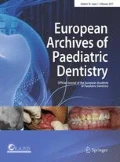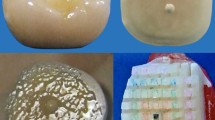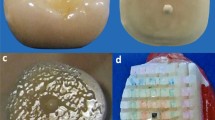Abstract
Objective
Physical and mechanical properties of three different (Ketac Molar Easymix, Dyract XP, Cention N (CN)) restoratives with different ingredients were evaluated.
Materials and methods
Four groups were obtained; Group 1: CN LightCure, Group 2: CN SelfCure, Group 3: Ketac Molar Easymix and Group 4: Dyract XP. Disk-shaped samples (n = 10) were prepared and evaluated for the surface roughness test using a profilometer. For the flexure strength test, 2 × 2 × 25 mm bar-shaped samples (n = 10) were prepared, and a three-point bending test was applied to the samples. After preparing cavities for microleakage tests, teeth were restored with restoratives, immersed in dye, and microleakage was assessed. For the microtensile bond strength (µTBS) test, ten sticks were obtained for each group and were stressed under tension.
Results
According to surface roughness tests, CN SelfCure showed the lowest value (0.13 μm), while Ketac Molar Easymix showed the highest value (0.28 μm), and significant differences were found between the groups. In flexural strength tests, the highest values were seen in CN SelfCure (82.94 MPa), with statistically significant differences between the groups. When CN SelfCure was applied with an adhesive, the teeth showed statistically decreased leakage than other groups on the gingival side. Higher leakage values were seen on the gingival side than the occlusal side in most groups, and the SelfCure groups showed decreased leakage than the LightCure groups. According to µTBS tests, the highest value was obtained in CN SelfCure-Adhesive group, while the lowest was in CN LightCure-Non-adhesive group. When µTBS was evaluated regardless of adhesive use, the SelfCure groups showed higher µTBS values than the LightCure groups. As a result of the µTBS and microleakage test, the difference between the use of CN with and without adhesive, regardless of the polymerization type, was found to be significant (p < 0.05).
Conclusion
Cention N showed better properties in SelfCure mode, compared to the rest materials tested, but further in vitro and in vivo studies are needed to investigate the effect of different polymerization modes and the oral environmental conditions.

Similar content being viewed by others
References
Alani AH, Toh CG. Detection of microleakage around dental restorations: a review. Oper Dent. 1997;22(4):173–85.
Asmussen E, Peutzfeldt A. Flexural strength and modulus of a step-cured resin composite. Acta Odontol Scand. 2004;62(2):87–90. https://doi.org/10.1080/00016350310008823.
Bahsi E, Sagmak S, Dayi B, Cellik O, Akkus Z. The evaluation of microleakage and fluoride release of different types of glass ionomer cements. Niger J Clin Pract. 2019;22(7):961–70. https://doi.org/10.4103/njcp.njcp_644_18.
Bollen CM, Lambrechts P, Quirynen M. Comparison of surface roughness of oral hard materials to the threshold surface roughness for bacterial plaque retention: a review of the literature. Dent Mater. 1997;13(4):258–69. https://doi.org/10.1016/s0109-5641(97)80038-3.
Chole D, Shah H, Kundoor S, Bakle S, Gandhi N, Hatte N. In vitro comparison of flexural strength of cention-n, bulkfill composites, light-cure nanocomposites and resin-modified glass ionomer cement. IOSR J Dental Med Sci (IOSR-JDMS). 2018;17(10):79â. https://doi.org/10.9790/0853-1710087982.
Chung S, Yap A, Chandra S, Lim C. Flexural strength of dental composite restoratives: comparison of biaxial and three-point bending test. J Biomed Mater Res. 2004;71(2):278–83. https://doi.org/10.1002/jbm.b.30103.
François P, Remadi A, Le Goff S, Abdel-Gawad S, Attal J-P, Dursun E. Flexural properties and dentin adhesion in recently developed self-adhesive bulk-fill materials. J Oral Sci. 2021;63(2):139–44. https://doi.org/10.2334/josnusd.20-0448.
Iftikhar N, Devashish BS, Gupta N, Natasha Ghambir R-S. A comparative evaluation of mechanical properties of four different restorative materials: an in vitro study. Int J Clin Pediatr Dentistry. 2019;12(1):47. https://doi.org/10.5005/jp-journals-10005-1592.
Kaur M, Khanna R, Malhotra S, Kaur R, Kaur G. Stereomicroscopic evaluation of microleakage using cention n and conventional glass ionomer cement: an invitro study. Indian J Comprehensive Dental Care (IJCDC). 2018;8(2):1143–5.
Khurshid Z, Zafar M, Qasim S, Shahab S, Naseem M, AbuReqaiba A. Advances in nanotechnology for restorative dentistry. Materials. 2015;8(2):717–31. https://doi.org/10.3390/ma8020717.
Korkmaz Y, Gurgan S, Firat E, Nathanson D. Shear bond strength of three different nano-restorative materials to dentin. Oper Dent. 2010;35(1):50–7. https://doi.org/10.2341/09-051-L.
Kumari CM, Bhat KM, Bansal R. Evaluation of surface roughness of different restorative composites after polishing using atomic force microscopy. J Conservative Dentistry JCD. 2016;19(1):56–62. https://doi.org/10.4103/0972-0707.173200.
Lambrechts P. Evaluation of clinical performance for posterior composite resins and dentin adhesives. Oper Dent. 1987;12:53–78.
Mallya PL, Acharya S, Ballal V, Ginjupalli K, Kundabala M, Thomas M. Profilometric study to compare the effectiveness of various finishing and polishing techniques on different restorative glass ionomer cements. J Interdiscip Dentistry. 2013;3(2):86–90. https://doi.org/10.4103/2229-5194.126867.
Meshram P, Meshram V, Palve D, Patil S, Gade V, Raut A. Comparative evaluation of microleakage around class v cavities restored with alkasite restorative material with and without bonding agent and flowable composite resin: An in vitro study. Indian J Dent Res. 2019;30(3):403–7. https://doi.org/10.4103/ijdr.IJDR_767_17.
Mishra A, Singh G, Singh S. Comparative evaluation of mechanical properties of cention n with conventionally used restorative materials—an in vitro study. Int J Prosthodont Restor Dent. 2018;8(4):120–4. https://doi.org/10.5005/jp-journals-10019-1219.
Mohamed NI, Safy RK, Elezz AFA. Microtensile bond strength, marginal leakage, and antibacterial effect of bulk fill resin composite with alkaline fillers versus incremental nanohybrid composite resin. Eur J Dentistry. 2021;15(3):425–32. https://doi.org/10.1055/s-0040-1721310.
Nagem Filho H, D’azevedo MTFS, Nagem HD, Marsola FP. Surface roughness of composite resins after finishing and polishing. Braz Dent J. 2003;14(1):37–41. https://doi.org/10.1590/s0103-64402003000100007.
Oznurhan F, Ozturk C. Evaluation of polypropylene fiber reinforced glass ionomer cement: a comparative in-vitro study. J Adv Oral Res. 2020;11(2):196–201. https://doi.org/10.1177/2320206820930490.
Park C, Park H, Lee J, Seo H, Lee S. Surface roughness and microbial adhesion after finishing of alkasite restorative material. J Korean Acad Pedtatr Dentistry. 2020;47(2):188–95. https://doi.org/10.5933/JKAPD.2020.47.2.188.
Peutzfeldt A. Compomers and glass ionomers: bond strength to dentin and mechanical properties. Am J Dent. 1996;9(6):259–63.
Powers J, Wataha J (2008) Dental materials: properties and manipulation mosby elsevier. United States of America
Rekha CV, Balagopal VJ. Comparative evaluation of tensile bond strength and microleakage of conventional glass ionomer cement, resin modified glass ionomer cement and compomer: an in vitro study. Contemp Clin Dentistry. 2012;3(3):282–7. https://doi.org/10.4103/0976-237X.103619.
Setty A, Nagesh J, Marigowda JC, Kumar Shivanna A, Paluvary SK, Ashwathappa GS. Comparative evaluation of surface roughness of novel resin composite cention n with filtek z350 xt: in vitro study. Int J Oral Care Res. 2019;7(1):15–7. https://doi.org/10.4103/INJO.INJO_9_19.
Acknowledgements
This study was supported by the Sivas Cumhuriyet University Scientific Research Projects with the project code of DIS-240.
Funding
This study was supported by the Sivas Cumhuriyet University Scientific Research Projects with the project code of DIS-240.
Author information
Authors and Affiliations
Contributions
FO involved in conception, design, data acquisition and interpretation, draft and critically revised the manuscript. BK involved in conception, design, data acquisition and interpretation, statistical analysis and writing some parts of manuscript.
Corresponding author
Ethics declarations
Conflict of interest
The authors deny any conflicts of interest related to this study.
Ethical approval
Ethical approval for this study was obtained from Cumhuriyet University Clinical Research Ethics Committee (2019-12/09) and the study was conducted at the Faculty of Dentistry, Department of Pediatric Dentistry, Cumhuriyet University.
Additional information
Publisher's Note
Springer Nature remains neutral with regard to jurisdictional claims in published maps and institutional affiliations.
Rights and permissions
About this article
Cite this article
Keskus, B., Oznurhan, F. Comparison of physical and mechanical properties of three different restorative materials in primary teeth: an in vitro study. Eur Arch Paediatr Dent 23, 821–828 (2022). https://doi.org/10.1007/s40368-022-00734-6
Received:
Accepted:
Published:
Issue Date:
DOI: https://doi.org/10.1007/s40368-022-00734-6




